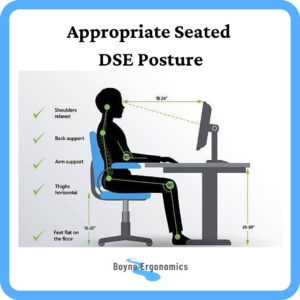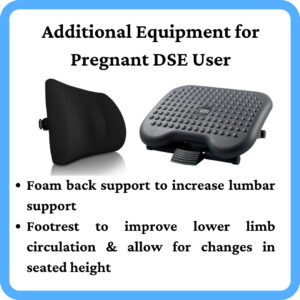Pregnancy presents a unique health and safety challenge in the workplace in that the employer is not only concerned about the welfare of the employee, but also their developing child. The impact of pregnancy on any employee is different and so it can be difficult to predict the effects pregnancy may have on an employee’s ability to safely carry out their tasks.
In Ireland, the Safety, Health and Welfare at Work (General Applications) Regulations 2007, Chapter 2 of Part 6: Protection of Pregnant, Post-Natal and Breastfeeding Employees apply from the time the employee notifies that they are pregnant, have given birth or are breastfeeding. These regulations outline the duties of the employer to reduce the risks present in the workplace that may cause harm to the pregnant employee and their developing child.
A Pregnancy Risk Assessment should be completed in the early stages of pregnancy and upon return to work to identify the potential risks and put in place strategies to eliminate or reduce the risks. If the risks cannot be removed or reduced, the employee’s working hours / conditions should be adjusted, they should be offered alternative roles or the employee should be granted Health and Safety Leave.
In this blog post, I summarise the workplace risks to the pregnant, post-natal and breastfeeding employee, the biological changes that may develop during pregnancy that can impact the ability to safely carry out work tasks and advice for pregnant DSE users to reduce discomfort and stress.
What Are The Workplace Risks To Pregnant, Post-Natal And Breastfeeding Employees?
The workplace risks that have been identified as having the potential to cause harm to the pregnant, post-natal or breastfeeding employee and their developing child are:
- Postures or movements that are abrupt, severe, or give risk to excessive fatigue
- Physical shocks, including direct blows to the abdomen
- Whole body vibration
- Manual handling
- Excessive heat or cold
- Ionising and non-ionising radiation
- Biological agents
- Chemical agents
- Stress
- Lead and lead substances
- Pressure chambers
- Confined space, underground mine work
Why Can Pregnancy Impact The Ability To Safely Complete Work Tasks?
Every pregnancy is different and the impact of a pregnancy on the ability to complete work tasks without undue discomfort and stress cannot usually be predicted in advance. I have had two pregnancies while based in the workplace, both had different effects on my body and I experienced differing workplace issues in each. The one common issue was that static postures caused increased low back pain, be it prolonged sitting or prolonged standing.
The effects or biological changes associated with pregnancy that can impact productivity, safety and comfort include:
- Morning sickness & nausea
- Back discomfort
- Hip / pelvic discomfort
- Increasing size
- Increasing frequency of urination
- Varicose veins
- Fatigue
- Impaired balance
- Impaired dexterity, agility, coordination, movement & reach
What Are The Risks Associated With DSE Use When Pregnant?
There is no direct risk to pregnant, post-natal or breastfeeding users from the DSE equipment itself. The risk stems from adverse postures, static postures and incorrect use of equipment.
Anyone who uses a computer in excess of 1 hour continuously per day is exposed to risk factors that may cause musculoskeletal injury – adverse, repetitive and static postures. The impact of these risk factors increases when the DSE user is pregnant.
Pregnant DSE users are at an increased risk of hip discomfort, lower back discomfort, carpal tunnel syndrome, swelling in the calves, ankles, feet and wrists, eye strain, headaches and migraines. This increase is due to a change in hormone levels in the body, increase in fluid retention and changes to the spinal curvature and centre of gravity due to the increasing size of the uterus.
How Can You Reduce The Health Risks Associated With DSE Use When Pregnant?
Identify the risks
From an employee perspective, the first thing to do is to notify your employee as soon as you are comfortable doing so. The earlier, the better to allow for the risk assessment process to commence, although is it common practice here in Ireland to wait until after 12 weeks.
From an employer perspective, as soon as you are notified that an employee is pregnant, you should arrange a risk assessment of their role and tasks, regardless of how “low-risk” their role is perceived to be. This allows for early identification of any risks and for time to implement risk mitigation measures.
Take regular microbreaks from the workstation
Static postures during pregnancy increase the risk of developing lower back and hip pain, eye strain and swelling in lower limbs and wrists.
When you are seated at the desk, there are approximately 29 different muscle groups keeping you upright in the chair. As these muscles contract, they produce lactic acid. When you stay seated for prolonged periods, this lactic acid can cause inflammation to the muscle tissues, causing fatigue, stiffness and discomfort.
Fatigue to these muscles can also cause you to adopt poor postures as the muscles tire from keeping you upright.
Prolonged sitting also slows the circulation. This can cause fluid to build up in the lower limbs and wrists, causing swelling, tingling, pins and needles and pain. This is why pregnant DSE users are at a higher risk of developing Carpal Tunnel Syndrome.
This fluid retention can also affect the vision if fluid builds up in or around the cornea, resulting in blurred vision.
Moving from the workstation, even for 30 – 60 seconds, will give the circulatory system a boost, keeping the fluid moving around the body and reducing the risk of swelling. It will also give the muscles that were activated when you were seated a chance to relax, promote lactic acid removal and replenish the muscle with oxygen and fuel for the next period of sitting.
In the first and second trimester, these microbreaks should be taken at least every 45 minutes. In the third trimester, these microbreaks should be taken at least every 30 minutes.
Note: If your role involves a high level of video calls, I advise investing a wireless headset to facilitate regular movement breaks during the calls.
Also, drink plenty of water! Trips to the kitchen and bathroom will increase your mobility from the desk!
Use DSE appropriate seating
The DSE seating should be a 5 spoke swivel chair on castors to allow for stability and ease of movement in and out of the workstation.
The seating should be height adjustable to allow the user to be seated at the appropriate height for the workstation, with a padded seat pan for comfort and support.
The seating should have a height and tilt adjustable backrest to allow for the lumbar support to be positioned correctly and for the back to be supported when in the typing position. If the backrest is mesh, it should have an additional adjustable lumbar support.
Padded armrests that can be adjusted in height, width and depth can be useful to provide additional support in the later stages when the bump might impact seated distance from the desk.

Ensure you are seated at the correct posture for a DSE workstation
Starting with the feet, they should be planted on the floor or a footrest. This provides the stable base. The hips should be slightly higher than the knees and elbows level with the work surface, or the keyboard if using a mechanical keyboard. The monitor should be high enough that the eyeline rests on the top 1/3 of the monitor when sitting upright and looking ahead with a relaxed neck. The back should be in contact with the backrest or back support and keyboard and mouse should be within easy reach when sitting back against the backrest.
This is to reduce excessive strain on the joints and tissues when seated at the desk and help maintain adequate circulation.

Increase the support at the DSE workstation using a footrest and foam back support
As the pregnancy progresses, the stress and strain on the lower back increases due to a deepening of the lumbar curve, an increase in the hormone relaxin increasing the laxity of the tissues of the spine, stretching and loosening of the abdominal muscles and increase in body weight.
It is vital that the lower back is supported when seated at the DSE workstation to take some of the load off the lumbar area and support the natural curvature. A foam back support will provide increased support and can be used on the office chair, kitchen chair and in the car.
A footrest is a useful accessory to have available when pregnant. Due to the changing size of the bump, it may be necessary to adjust your seated height relative to the desk so you can be comfortable when typing. Having a footrest available means you can adjust your height, while still keeping a stable base if your feet cannot comfortably reach the floor.
They are also useful to have under the desk even if you can plant your feet on the floor. Alternating between planting your feet on the floor and the footrest will raise your thighs from the seat of the chair slightly and encourage movement, improving circulation in the lower limbs.
A useful alternative to the traditional footrest for pregnant DSE users is a foam roller. These can provide the stability of a footrest, with increased mobility of the lower limbs.

Ensure you are using the mouse and keyboard correctly
Firstly, hold the mouse loosely in your palm and avoid gripping the mouse when moving it.
Do not rest your wrist on the work surface or use a wrist rest when moving the mouse as it can reduce blood flow to the wrist and compresses the tendons and nerves.
Use the whole arm to move the mouse, keeping the wrist straight. If you have an adjustable armrest, adjust it so that it sits just under the elbow to help maintain a horizontal forearm and support whole arm movement of the mouse.
This will help reduce compression, tension in the forearm, wrist and hand, maintain blood flow and reduce the repetitive micromovements associated with moving the mouse using just the hand. A vertical mouse can be a useful addition to a DSE workstation for employees experiencing wrist discomfort during pregnancy.
When typing, again try and float the wrists instead of letting them rest on the work surface or keyboard rest. Move your hand across the keyboard as required, maintaining a straight line from forearm to hand, avoiding deviating the hands. If you find this difficult, using a keyboard rest under the palms of your hands can help minimise contact stress on the wrists. Another option to consider is activating the Speech to Text feature in Windows to reduce the amount of typing required when completing work tasks.
On occasion, changing to an adjustable split keyboard can help reduce wrist discomfort during pregnancy.
Pause regularly when typing and using the mouse.
Check out my blog posts on keyboard and mouse use for more information.
Maintain open communication with management
Open communication with management about current abilities and workload can reduce anxiety and stress.
Pace your work, set manageable deadlines and expectations and do not hesitate to request assistance or delegate tasks if you feel the workload is excessive.
If you start experiencing discomfort while working, notify management.
Looking after your musculoskeletal health when pregnant is vital because the pregnancy is just the start! When the baby arrives you will sit, walk, rock, bounce, lie and carry in all different postures and shapes and a healthy musculoskeletal system will help you move freely and pain free.
For a complete guide to the Safety, Health and Welfare at Work (General Applications) Regulations 2007, Chapter 2 of Part 6: Protection of Pregnant, Post-Natal and Breastfeeding Employees and how to reduce the risks in your workplace, visit the Health and Safety Authority at www.hsa.ie.


